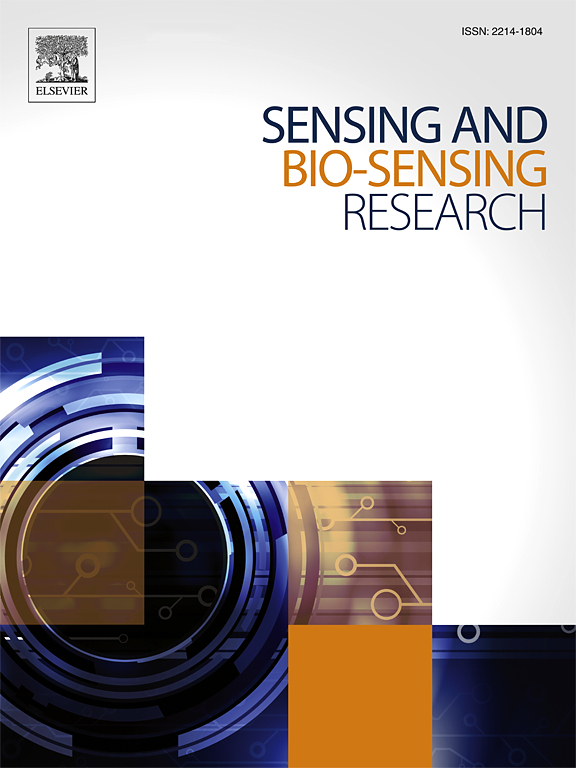Emphasis on sensitivity and accuracy: Design and optimization of a high-sensitivity terahertz photonic crystal fiber sensor for precision analysis of petrochemical-based adulterants in hydrocarbon mixtures
IF 4.9
Q1 CHEMISTRY, ANALYTICAL
引用次数: 0
Abstract
This study introduces an innovative octagonal cladding with hollow-core photonic crystal fiber (PCF) sensor designed for the identification of kerosene adulteration within the terahertz (THz) spectral domain. The sensor's performance is rigorously assessed through simulations conducted using COMSOL Multiphysics, a high-fidelity platform based on the finite element method (FEM) for analyzing complex electromagnetic behaviors within the fiber structure. The sensor's performance was estimated throughout numerical simulations across frequencies varying from 1.0 to 3 THz. Simulation results demonstrate that the optimized design achieves an outstanding relative sensitivity of 97.20% at a target frequency of 2.2 THz, markedly surpassing the capabilities of existing sensing technologies. Moreover, the sensor exhibits extremely low confinement loss, measured at 6.08 × 10−8 dB/m, along with a minimal effective material loss of 0.00654 cm−1. These characteristics enable the precise detection of minute refractive index differences associated with the unique chemical profiles of various petroleum-based fuels. The high sensitivity and low-loss performance of the proposed sensor support non-invasive and non-destructive testing, ensuring that the samples remain unaltered during analysis. The exceptional sensitivity and accuracy of the proposed sensing system position it as a highly effective solution for detecting kerosene adulteration, thereby safeguarding the quality of petroleum-based fuels for end users. Furthermore, advanced fabrication methods such as extrusion and additive manufacturing may be utilized to produce the photonic crystal fiber-based sensor with enhanced structural precision and scalability.
强调灵敏度和准确性:高灵敏度太赫兹光子晶体光纤传感器的设计与优化,用于精确分析烃类混合物中石油化工类掺杂物
本研究介绍了一种创新的八角形包层空心光子晶体光纤传感器,用于太赫兹(THz)光谱域内煤油掺假的识别。该传感器的性能通过COMSOL Multiphysics进行了严格的仿真评估,COMSOL Multiphysics是一个基于有限元法(FEM)的高保真平台,用于分析光纤结构内的复杂电磁行为。通过数值模拟估计了传感器的性能,频率从1.0到3thz不等。仿真结果表明,优化后的设计在2.2太赫兹目标频率下的相对灵敏度达到了97.20%,明显超过了现有传感技术的能力。此外,该传感器具有极低的约束损耗,测量值为6.08 × 10−8 dB/m,以及最小的有效材料损耗为0.00654 cm−1。这些特性能够精确地检测与各种石油基燃料的独特化学特征相关的微小折射率差异。该传感器的高灵敏度和低损耗性能支持非侵入性和非破坏性检测,确保样品在分析过程中保持不变。所提出的传感系统的特殊灵敏度和准确性使其成为检测煤油掺假的高效解决方案,从而为最终用户保障石油基燃料的质量。此外,可以利用先进的制造方法,如挤压和增材制造来生产具有更高结构精度和可扩展性的光子晶体光纤传感器。
本文章由计算机程序翻译,如有差异,请以英文原文为准。
求助全文
约1分钟内获得全文
求助全文
来源期刊

Sensing and Bio-Sensing Research
Engineering-Electrical and Electronic Engineering
CiteScore
10.70
自引率
3.80%
发文量
68
审稿时长
87 days
期刊介绍:
Sensing and Bio-Sensing Research is an open access journal dedicated to the research, design, development, and application of bio-sensing and sensing technologies. The editors will accept research papers, reviews, field trials, and validation studies that are of significant relevance. These submissions should describe new concepts, enhance understanding of the field, or offer insights into the practical application, manufacturing, and commercialization of bio-sensing and sensing technologies.
The journal covers a wide range of topics, including sensing principles and mechanisms, new materials development for transducers and recognition components, fabrication technology, and various types of sensors such as optical, electrochemical, mass-sensitive, gas, biosensors, and more. It also includes environmental, process control, and biomedical applications, signal processing, chemometrics, optoelectronic, mechanical, thermal, and magnetic sensors, as well as interface electronics. Additionally, it covers sensor systems and applications, µTAS (Micro Total Analysis Systems), development of solid-state devices for transducing physical signals, and analytical devices incorporating biological materials.
 求助内容:
求助内容: 应助结果提醒方式:
应助结果提醒方式:


